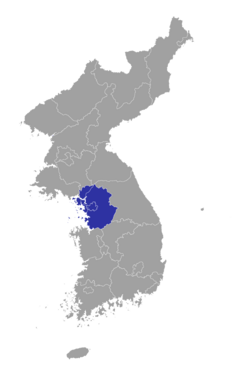Top Qs
Timeline
Chat
Perspective
Gyeonggi (region)
Central region of the Korean Peninsula From Wikipedia, the free encyclopedia
Remove ads
Gyeonggi (Korean: 경기; Hanja: 京畿), alternatively spelled Kyŏnggi or Kyunggi, is a region of the Korean Peninsula that has historically occupied the west-central region of Korea. In modern times, the region hosts South Korea's Gyeonggi Province and Incheon Metropolitan City, and North Korea's Kaesong Industrial Region, and Changpung, and Ch'ŏrwŏn counties.
Remove ads
Etymology
The current name of the region, Gyeonggi, comes from a combination of Gyeong (京/경; "capital") and Gi (畿/기; "near"), ultimately from Gyeonghyeon (京縣/경현) and Gihyeon (畿縣/기현) in relation to the location of the capital, Gaegyeong (modern day Kaesŏng, North Korea). The name means "Area Surrounding the Capital", and was first used in 1018 during the Goryeo dynasty.[1] Prior, the region was called Gwannae-do (關內道/관내도).[2]
Remove ads
History
Summarize
Perspective
Unified Silla and Goryeo
Towards the end of the Three Kingdoms period, the southeastern kingdom of Silla unified the Korean Peninsula up to the Taedong River and moved the capital from Gyeongju to Kaesong shortly thereafter. Gyeonggi originally a frontier region to Kaesong, as well as the secondary capital Namgyeong (modern-day Seoul, South Korea).[3]
Joseon and Korean Empire periods
In 1392, general Yi Seong-gye, later 'Taejo of Joseon', waged successful a coup against the Goryeo dynasty and founded the Joseon dynasty. Two years later, Taejo moved the capital south to Hanseong (modern-day Seoul).[4] During the Joseon dynasty, Hanseong served not only as the national capital, but the provincial capital as well. Gyeonggi was one of the Eight Provinces (팔도 paldo), until 1895 when King Gojong created the 23 District system, splitting Gyeonggi into five districts, or bu (府/부):
- Hanseong-bu (韓城府/한성부)
- Incheon-bu (仁川府/인천부)
- Gaeseong-bu (改城府/개성부)
- Gongju-bu (公洲府/공주부)
- Chungju-bu (忠州府/충주부)
One year later, the 23 districts were reorganized into eighteen provinces. In 1910, the Korean Empire was annexed into the Empire of Japan. Japanese Korea, or Chōsen (Kanji: 朝鮮), was administered from Keijō (JP: 京城; Korean: 경성), and was surrounded by Keiki-dō.
Contemporary history (1945–present)
Korea was liberated from Japan in 1945, and the People's Republic of Korea, a provisional government, was founded shortly after. The provisional republic remained a sovereign, independent state for several days, until the United States and Soviet Union devised a plan to temporary partition Korea into two occupied zones, then reunify the peninsula once it was determined that the Koreans were fit to govern themselves.
Korea was divided at the 38th parallel north, which divided Korea roughly in half. Korea south of the 38th parallel was occupied by the United States Army Military Government in Korea. Most of Gyeonggi, including Kaesong, fell under the American occupation zone. By the end of the war, Kaesong was one of the only cities to officially change hands, going from a South Korean city to a North Korean city.
Remove ads
Administrative divisions
Summarize
Perspective
Both Korean governments claim sovereignty over the whole of the Korean Peninsula, and neither governments recognize changes to Korea's internal divisions made by the other.
Administrative divisions of Kyŏnggi (North Korea)
Kyŏnggi falls under one of the seven claimed provinces of North Korea.
Cities of Kyŏnggi-do
|
Counties of Kyŏnggi-do
Areas of South Hwanghae and Kangwŏn in the Kyŏnggi region
|
Administrative divisions of Gyeonggi (South Korea)
Remove ads
References
Wikiwand - on
Seamless Wikipedia browsing. On steroids.
Remove ads


